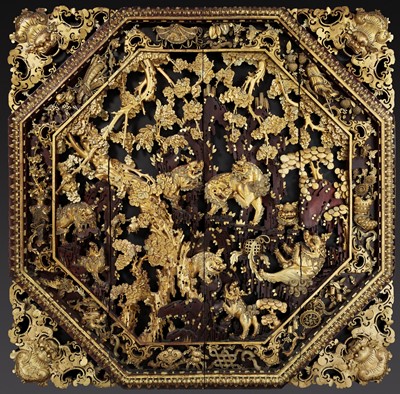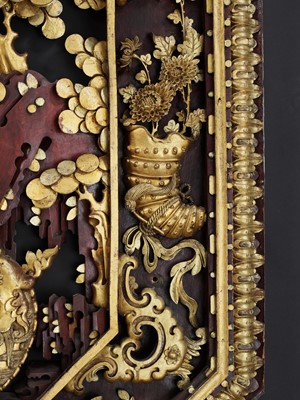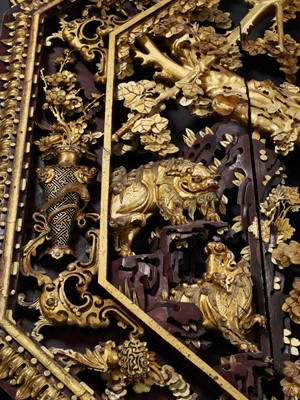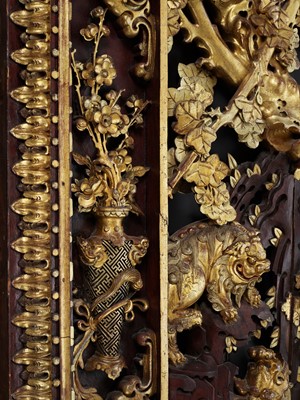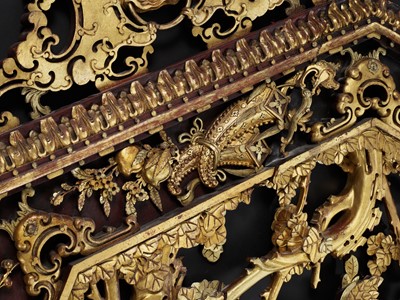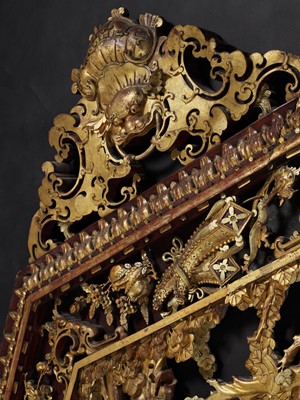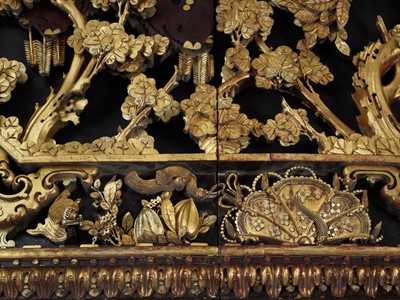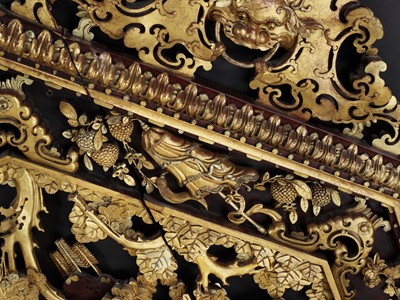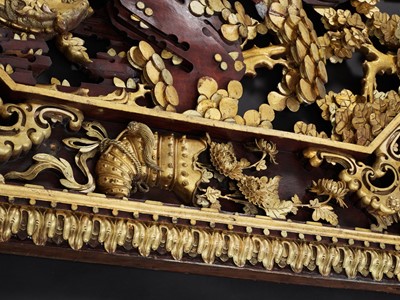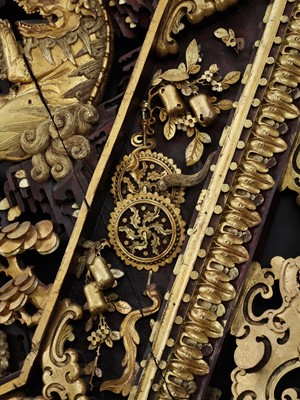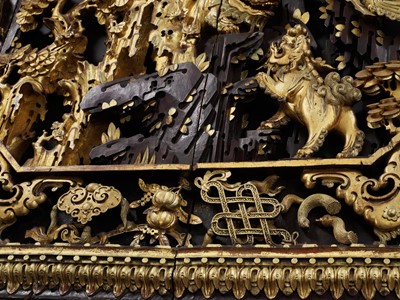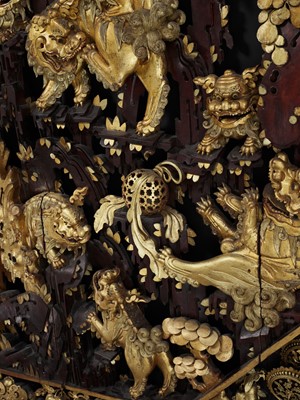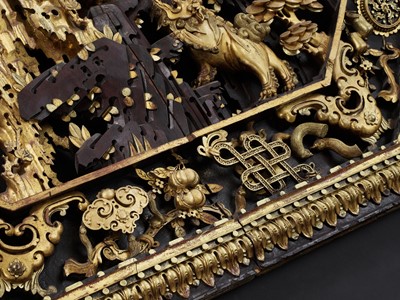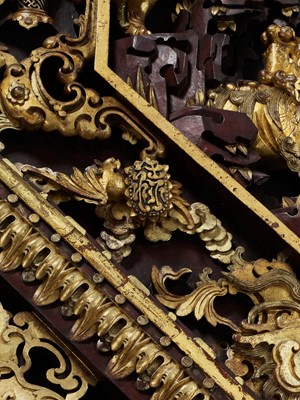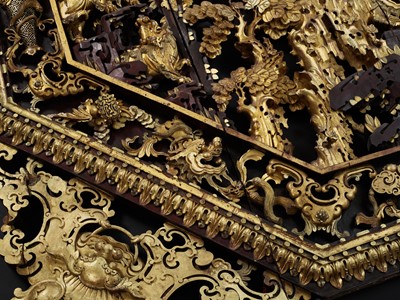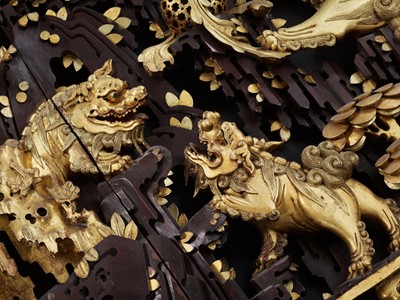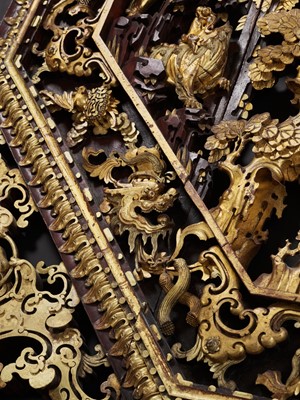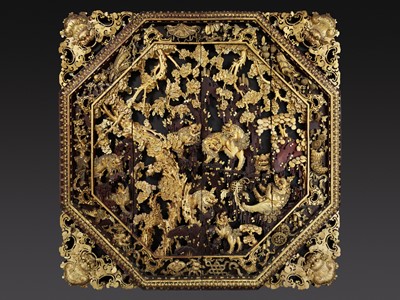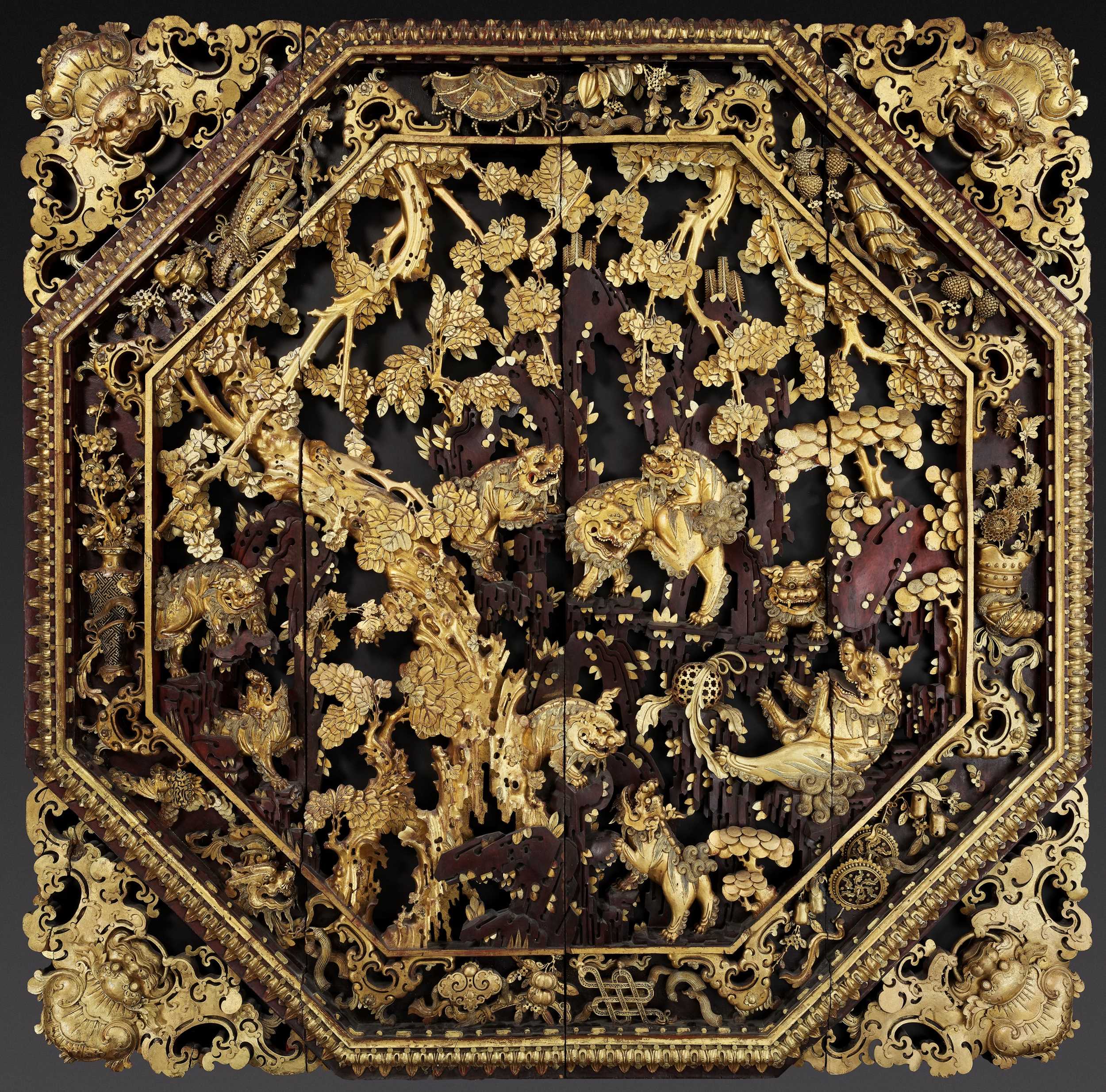11th Mar, 2022 10:00
DAY 2 - TWO-DAY AUCTION - Fine Chinese Art / 中國藝術集珍 / Buddhism & Hinduism
419
A MONUMENTAL LACQUERED AND GILT WOOD ‘TAISHI SHAOSHI’ OPENWORK WALL PANEL, QING DYNASTY
清代金漆木雕太獅少獅掛屏
Sold for €42,976
including Buyer's Premium
China, 1644-1912. Of square form, composed of four rectangular panels, finely carved with nine Buddhist lions, mostly in groups of two where one is larger than the other (taishi shaoshi), amid trees and rockwork, enclosed by an octagonal border surrounded by a band of auspicious and Buddhist symbols, including peaches, a vase with flowering prunus, a horn with chrysanthemums, a parasol, a double gourd, a Dharma wheel and flywhisk, an endless knot, and a dragon head. The four corners of the panel each with a bat amid scrolling clouds. (4)
Provenance: French private collection. Acquired in the Swiss market.
Condition: Good condition with old wear, chips, losses. Minor old repairs, fills and touchups here and there. One panel was broken in two parts and is now backed by an additional wood frame for stabilization. Overall displaying remarkably well.
Dimensions: Size 227 x 228 cm
The present panel carries an important auspicious meaning: A large Buddhist lion (dashi) and his small counterpart (xiaoshi) shown together form the rebus ‘may you and your descendants achieve high rank’ (taishi shaoshi). During the Western Zhou dynasty, taishi was the highest military rank of the period. During the Warring States, the Kingdom of Chu established the rank of shaoshi, which represents the tutor to the prince. Mount Song, one of China’s sacred Daoist mountains, is divided into the Taishi and the Shaoshi Mountain.
Lions are not native to China, and although live animals were brought to the Chinese court by foreign embassies since at least the Han dynasty (206 BC – AD 220), they were always exotic rarities. In India, the lion is intimately associated with Buddhism, considered a symbol of strength and protector of the Dharma, the Buddhist law, and with the growing popularity of the Buddhist religion during the Tang dynasty (618-907), pairs of lion figures were increasingly placed in front of Buddhist temple gates as guardian animals.
The Yongle Emperor’s international diplomacy efforts brought China once more in direct contact with foreign lands, their animals, plants and other exotica in the early Ming dynasty. The court welcomed foreign embassies and the Muslim seafarer and diplomat, Court Eunuch Zheng He (c. 1371-1435), embarked on seven extensive maritime expeditions to ports throughout Asia and as far as Africa, which continued into the Xuande reign. At this time, lions were apparently so little known in China that Ma Huan (c. 1380-1460), Zheng He’s Muslim interpreter who accompanied him on three voyages, left us a contemporary account describing them in detail: “The lion has a body which resembles a tiger’s in shape; it is a dark-yellow color, without stripes; it has a large head and a broad mouth; the tail tapers to a point, which has a lot of hair, black and long, like a tassel; the noise of its roar is like thunder. All the beasts, when they see it, fall down and dare not rise; it is indeed the king among the beasts” (J.V.G. Mills, ed., Ma Huan, Ying-yai Sheng-lan. The Overall Survey of the Ocean’s Shores [1433], Hakluyt Society, London, 1970, reprint Bangkok 1997, p. 158-159).
Although lions were among the exotic animals that had been brought to China already by some Timurid embassies, and on occasion were received as tribute by Zheng He’s delegation, they were rare and desirable enough to be specially purchased on these voyages and be brought back to the court: during the sixth expedition in the Yongle reign, for example, when in 1421 the ships stopped in Aden (ibid., p. 50 and 159), and during the seventh voyage in the Xuande reign, when in 1431 a division of the fleet went to Mecca, where it had, among other things, brought porcelain items as gifts (ibid., p. 51 and 178).
清代金漆木雕太獅少獅掛屏
中國,1644-1912年。方形,由四塊長方形板組成,精心雕刻九隻獅子,多為一組兩隻,一大一小,太獅少獅,在樹木和山岩之間,或是戲珠,或是捉迷藏,或是相互嬉戲;四角如意蝙蝠紋,中央成六角形,邊界之間飾佛教八寶紋如寶瓶、寶蓋、寶瓶、葫蘆、螺、吉祥結、幢、法輪以及龍頭。多層次鏤空的立體設計,層層疊疊,玲瓏剔透。
來源:法國私人收藏,購於瑞士古玩市場。
品相:狀況良好,有舊磨損、磕損、缺損;局部有輕微的維修、填充和修飾。 一塊面板被分成兩部分,現在由一塊額外的木框架支撐以保持穩定。整體狀況非常好。
尺寸:227 x 228 厘米
太獅少獅是中國傳統的吉祥題材,寓意子嗣繁衍。而且大小獅子經常一起出現,也象徵古代官職“太師”“少師”之職,也象徵著世代高官厚祿。在商周時,分立三公:太師、太傅和太保。太師是三公中官最大地位最尊貴的,因此民間常把獅子比喻成是太獅。另外,嵩山是中國道教聖山之一,那兒有太師山和少師山。
獅子並非源於中國,從漢朝(西元前 206 年 - 西元 220 年)起,外國使臣就將獅子帶到了中國宮廷,但它們始終屬於帶有異國情調的稀有動物。在印度,獅子與佛教有著密切的聯繫,被認為是力量的象徵和佛法的保護者,隨著佛教在唐朝(618-907 年)的日益普及,成對的獅子形像被越來越多地用在佛寺大門前作為守護動物。
明朝初年,永樂帝的國際外交使中國再次與外國進行接觸與交流。朝廷歡迎外國使臣,而鄭和(約 1371-1435 年)開始了七次海上遠征,遍及亞洲各地的港口,遠至非洲,一直到宣德時期。當時,獅子在中國顯然鮮為人知,鄭和的翻譯馬歡(約 1380-1460 年)曾陪同他三下西洋,他的《瀛涯勝覽》一書,也記錄了一份關於獅子的描述,更顯彌足珍貴。獅子是被使臣帶到中國的珍稀動物之一,鄭和的代表團也將它們作為貢品,它們非常稀有。
China, 1644-1912. Of square form, composed of four rectangular panels, finely carved with nine Buddhist lions, mostly in groups of two where one is larger than the other (taishi shaoshi), amid trees and rockwork, enclosed by an octagonal border surrounded by a band of auspicious and Buddhist symbols, including peaches, a vase with flowering prunus, a horn with chrysanthemums, a parasol, a double gourd, a Dharma wheel and flywhisk, an endless knot, and a dragon head. The four corners of the panel each with a bat amid scrolling clouds. (4)
Provenance: French private collection. Acquired in the Swiss market.
Condition: Good condition with old wear, chips, losses. Minor old repairs, fills and touchups here and there. One panel was broken in two parts and is now backed by an additional wood frame for stabilization. Overall displaying remarkably well.
Dimensions: Size 227 x 228 cm
The present panel carries an important auspicious meaning: A large Buddhist lion (dashi) and his small counterpart (xiaoshi) shown together form the rebus ‘may you and your descendants achieve high rank’ (taishi shaoshi). During the Western Zhou dynasty, taishi was the highest military rank of the period. During the Warring States, the Kingdom of Chu established the rank of shaoshi, which represents the tutor to the prince. Mount Song, one of China’s sacred Daoist mountains, is divided into the Taishi and the Shaoshi Mountain.
Lions are not native to China, and although live animals were brought to the Chinese court by foreign embassies since at least the Han dynasty (206 BC – AD 220), they were always exotic rarities. In India, the lion is intimately associated with Buddhism, considered a symbol of strength and protector of the Dharma, the Buddhist law, and with the growing popularity of the Buddhist religion during the Tang dynasty (618-907), pairs of lion figures were increasingly placed in front of Buddhist temple gates as guardian animals.
The Yongle Emperor’s international diplomacy efforts brought China once more in direct contact with foreign lands, their animals, plants and other exotica in the early Ming dynasty. The court welcomed foreign embassies and the Muslim seafarer and diplomat, Court Eunuch Zheng He (c. 1371-1435), embarked on seven extensive maritime expeditions to ports throughout Asia and as far as Africa, which continued into the Xuande reign. At this time, lions were apparently so little known in China that Ma Huan (c. 1380-1460), Zheng He’s Muslim interpreter who accompanied him on three voyages, left us a contemporary account describing them in detail: “The lion has a body which resembles a tiger’s in shape; it is a dark-yellow color, without stripes; it has a large head and a broad mouth; the tail tapers to a point, which has a lot of hair, black and long, like a tassel; the noise of its roar is like thunder. All the beasts, when they see it, fall down and dare not rise; it is indeed the king among the beasts” (J.V.G. Mills, ed., Ma Huan, Ying-yai Sheng-lan. The Overall Survey of the Ocean’s Shores [1433], Hakluyt Society, London, 1970, reprint Bangkok 1997, p. 158-159).
Although lions were among the exotic animals that had been brought to China already by some Timurid embassies, and on occasion were received as tribute by Zheng He’s delegation, they were rare and desirable enough to be specially purchased on these voyages and be brought back to the court: during the sixth expedition in the Yongle reign, for example, when in 1421 the ships stopped in Aden (ibid., p. 50 and 159), and during the seventh voyage in the Xuande reign, when in 1431 a division of the fleet went to Mecca, where it had, among other things, brought porcelain items as gifts (ibid., p. 51 and 178).
清代金漆木雕太獅少獅掛屏
中國,1644-1912年。方形,由四塊長方形板組成,精心雕刻九隻獅子,多為一組兩隻,一大一小,太獅少獅,在樹木和山岩之間,或是戲珠,或是捉迷藏,或是相互嬉戲;四角如意蝙蝠紋,中央成六角形,邊界之間飾佛教八寶紋如寶瓶、寶蓋、寶瓶、葫蘆、螺、吉祥結、幢、法輪以及龍頭。多層次鏤空的立體設計,層層疊疊,玲瓏剔透。
來源:法國私人收藏,購於瑞士古玩市場。
品相:狀況良好,有舊磨損、磕損、缺損;局部有輕微的維修、填充和修飾。 一塊面板被分成兩部分,現在由一塊額外的木框架支撐以保持穩定。整體狀況非常好。
尺寸:227 x 228 厘米
太獅少獅是中國傳統的吉祥題材,寓意子嗣繁衍。而且大小獅子經常一起出現,也象徵古代官職“太師”“少師”之職,也象徵著世代高官厚祿。在商周時,分立三公:太師、太傅和太保。太師是三公中官最大地位最尊貴的,因此民間常把獅子比喻成是太獅。另外,嵩山是中國道教聖山之一,那兒有太師山和少師山。
獅子並非源於中國,從漢朝(西元前 206 年 - 西元 220 年)起,外國使臣就將獅子帶到了中國宮廷,但它們始終屬於帶有異國情調的稀有動物。在印度,獅子與佛教有著密切的聯繫,被認為是力量的象徵和佛法的保護者,隨著佛教在唐朝(618-907 年)的日益普及,成對的獅子形像被越來越多地用在佛寺大門前作為守護動物。
明朝初年,永樂帝的國際外交使中國再次與外國進行接觸與交流。朝廷歡迎外國使臣,而鄭和(約 1371-1435 年)開始了七次海上遠征,遍及亞洲各地的港口,遠至非洲,一直到宣德時期。當時,獅子在中國顯然鮮為人知,鄭和的翻譯馬歡(約 1380-1460 年)曾陪同他三下西洋,他的《瀛涯勝覽》一書,也記錄了一份關於獅子的描述,更顯彌足珍貴。獅子是被使臣帶到中國的珍稀動物之一,鄭和的代表團也將它們作為貢品,它們非常稀有。
Zacke Live Online Bidding
Our online bidding platform makes it easier than ever to bid in our auctions! When you bid through our website, you can take advantage of our premium buyer's terms without incurring any additional online bidding surcharges.
To bid live online, you'll need to create an online account. Once your account is created and your identity is verified, you can register to bid in an auction up to 12 hours before the auction begins.
Intended Spend and Bid Limits
When you register to bid in an online auction, you will need to share your intended maximum spending budget for the auction. We will then review your intended spend and set a bid limit for you. Once you have pre-registered for a live online auction, you can see your intended spend and bid limit by going to 'Account Settings' and clicking on 'Live Bidding Registrations'.
Your bid limit will be the maximum amount you can bid during the auction. Your bid limit is for the hammer price and is not affected by the buyer’s premium and VAT. For example, if you have a bid limit of €1,000 and place two winning bids for €300 and €200, then you will only be able to bid €500 for the rest of the auction. If you try to place a bid that is higher than €500, you will not be able to do so.
Online Absentee and Telephone Bids
You can now leave absentee and telephone bids on our website!
Absentee Bidding
Once you've created an account and your identity is verified, you can leave your absentee bid directly on the lot page. We will contact you when your bids have been confirmed.
Telephone Bidding
Once you've created an account and your identity is verified, you can leave telephone bids online. We will contact you when your bids have been confirmed.
Classic Absentee and Telephone Bidding Form
You can still submit absentee and telephone bids by email or fax if you prefer. Simply fill out the Absentee Bidding/Telephone bidding form and return it to us by email at office@zacke.at or by fax at +43 (1) 532 04 52 20. You can download the PDF from our Upcoming Auctions page.
How-To Guides
How to Create Your Personal Zacke Account
How to Register to Bid on Zacke Live
How to Leave Absentee Bids Online
How to Leave Telephone Bids Online
中文版本的操作指南
创建新账号
注册Zacke Live在线直播竞拍(免平台费)
缺席投标和电话投标
Third-Party Bidding
We partner with best-in-class third-party partners to make it easy for you to bid online in the channel of your choice. Please note that if you bid with one of our third-party online partners, then there will be a live bidding surcharge on top of your final purchase price. You can find all of our fees here. Here's a full list of our third-party partners:
- 51 Bid Live
- EpaiLive
- ArtFoxLive
- Invaluable
- LiveAuctioneers
- the-saleroom
- lot-tissimo
- Drouot
Please note that we place different auctions on different platforms. For example, in general, we only place Chinese art auctions on 51 Bid Live.
Bidding in Person
You must register to bid in person and will be assigned a paddle at the auction. Please contact us at office@zacke.at or +43 (1) 532 04 52 for the latest local health and safety guidelines.
